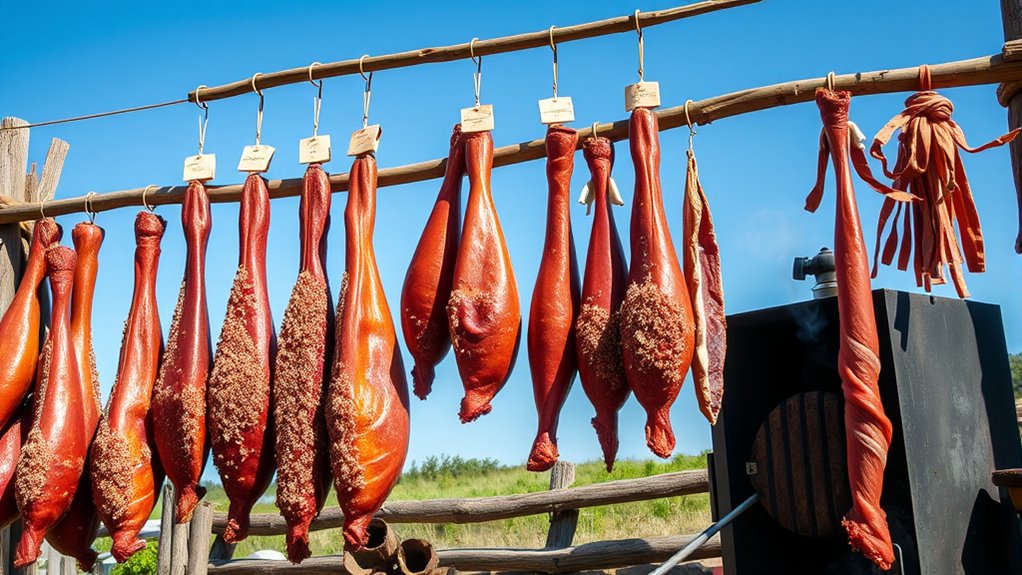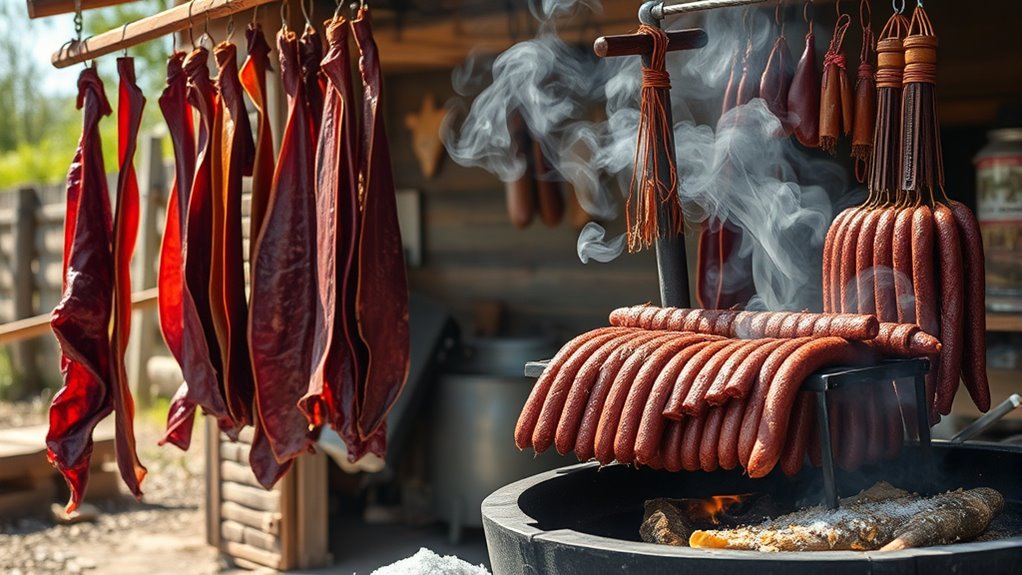To preserve meat without electricity, you can use traditional methods like curing, smoking, and drying. Salt helps prevent spoilage by creating an environment where beneficial bacteria thrive, while smoking adds antimicrobial compounds and reduces moisture. Drying involves removing excess water in a well-ventilated space, hindering bacteria growth. Combining these techniques offers a reliable way to store meat for months. Keep exploring to discover detailed steps and tips for each method.
Key Takeaways
- Use generous salting to create a hostile environment for bacteria and promote lactic acid fermentation.
- Smoke the meat using a simple setup to add antimicrobial compounds and reduce moisture content.
- Hang thin, salted meat in a well-ventilated, low-humidity area for effective air-drying.
- Combine salting, smoking, and drying techniques for extended preservation and protection against spoilage.
- Maintain sanitation, consistent temperature, and pest control to ensure safe, long-term storage without electricity.

Preserving meat without electricity is essential for those living off-grid, during power outages, or seeking sustainable food storage methods. One of the most reliable ways to extend the shelf life of your meat is through fermentation techniques, a traditional storage method that has been used for centuries. Fermentation not only preserves meat but also enhances its flavor and digestibility. To start, you’ll need to salt your meat generously, creating a hospitable environment for beneficial bacteria. This process suppresses spoilage organisms and encourages fermentation. As the salt draws out moisture, bacteria such as Lactobacillus begin to convert sugars into lactic acid, creating an environment that’s inhospitable to pathogens. This method, often used in making traditional cured meats like salami or sausages, relies on careful control of salt and temperature to ensure proper fermentation. Incorporating proper sanitation and controlled conditions is crucial to prevent contamination during fermentation and ensure safety. Beyond fermentation, smoking is another traditional storage method that has stood the test of time. Smoking meat involves exposing it to smoke from burning or smoldering wood, which imparts flavor and acts as an antimicrobial agent. The smoke contains compounds that inhibit bacterial growth, while the drying effect of the smoke further reduces moisture content, making the meat less prone to spoilage. You can set up a simple smoker using a metal drum or a makeshift fire pit with a grate above the smoke source. The key is maintaining a consistent temperature and ensuring the smoke circulates evenly around the meat. Smoking can be done over several hours or days, depending on the thickness and type of meat. Once smoked, the meat can be hung in a cool, dry place to cure further, extending its shelf life without refrigeration. Drying, or air-drying, is perhaps the most straightforward traditional storage method. It involves removing moisture from meat to prevent bacterial growth. To do this effectively, you’ll need a well-ventilated space, preferably with low humidity. Cut the meat into thin strips or pieces, salt them lightly, and hang them in a cool, shaded area. Over time, the moisture evaporates, leaving behind dried meat that’s safe to store for months or even years. For added preservation, you can combine drying with salting or smoking. The key is to keep the meat away from pests and moisture, which could accelerate spoilage. Using these traditional storage methods, you can maintain a steady supply of preserved meat without relying on electricity, ensuring food security during emergencies or in off-grid living situations.
Frequently Asked Questions
How Long Can Cured Meat Last Without Refrigeration?
Cured meat can last several months without refrigeration if proper curing agents are used, which inhibit meat spoilage. The length depends on the curing process, storage conditions, and type of meat. You should always check for signs of spoilage, like off odors or sliminess, before consuming. Properly cured and stored meat can stay safe for extended periods, making it a reliable preservation method when electricity isn’t available.
What Types of Wood Are Best for Smoking Meat?
You’re curious about the best wood types for smoking meat, and the answer lies in choosing the right smoking woods. Hardy woods like hickory and oak provide rich, robust flavors, while fruit woods like apple and cherry add a sweet, mild aroma. Avoid softwoods like pine, which can produce undesirable flavors. Selecting the right smoking woods enhances your meat’s taste, making the smoking process both an art and a science.
Can Dried Meat Be Stored at Room Temperature Safely?
Dried meat can be stored at room temperature safely if you follow proper storage conditions. When stored correctly, dried meat’s shelf life extends, reducing spoilage risks. Keep it in a cool, dry, airtight container away from direct sunlight and moisture. This prevents bacteria growth and maintains quality. Always check for signs of spoilage before consumption. Proper storage conditions ensure your dried meat stays safe and tasty for longer periods.
What Are Common Mistakes When Curing Meat Manually?
Think of curing as a delicate dance where timing and precision are your partners. You might ruin the meat texture if you choose the wrong curing salt or rush the process. Common mistakes include using improper curing salt choices, which can lead to unsafe bacteria growth, or not evenly distributing the cure, leaving spots of uncured meat. Pay close attention to your curing method to guarantee safe, flavorful results.
How Does Humidity Affect Drying and Curing Processes?
Humidity levels play a vital role in drying and curing meat. Too much humidity, or poor humidity control, keeps moisture levels high, which can lead to spoilage or mold. Low humidity speeds up drying but risks over-drying or cracking the meat. You need to monitor and regulate humidity carefully, ensuring moisture levels are balanced for effective curing and drying, resulting in safe, preserved meat with the right texture and flavor.
Conclusion
Just like a master chef carefully preserves flavors, you can keep your meat fresh without electricity using curing, smoking, and drying. Imagine your favorite grandma, who kept homemade jerky in a cool cellar during tough winters, ensuring every bite was a taste of resilience. These ancient techniques turn raw meat into lasting treasures, proving that with patience and skill, you can master preservation just as well as any modern gadget. Embrace these methods, and your food will stand the test of time.











